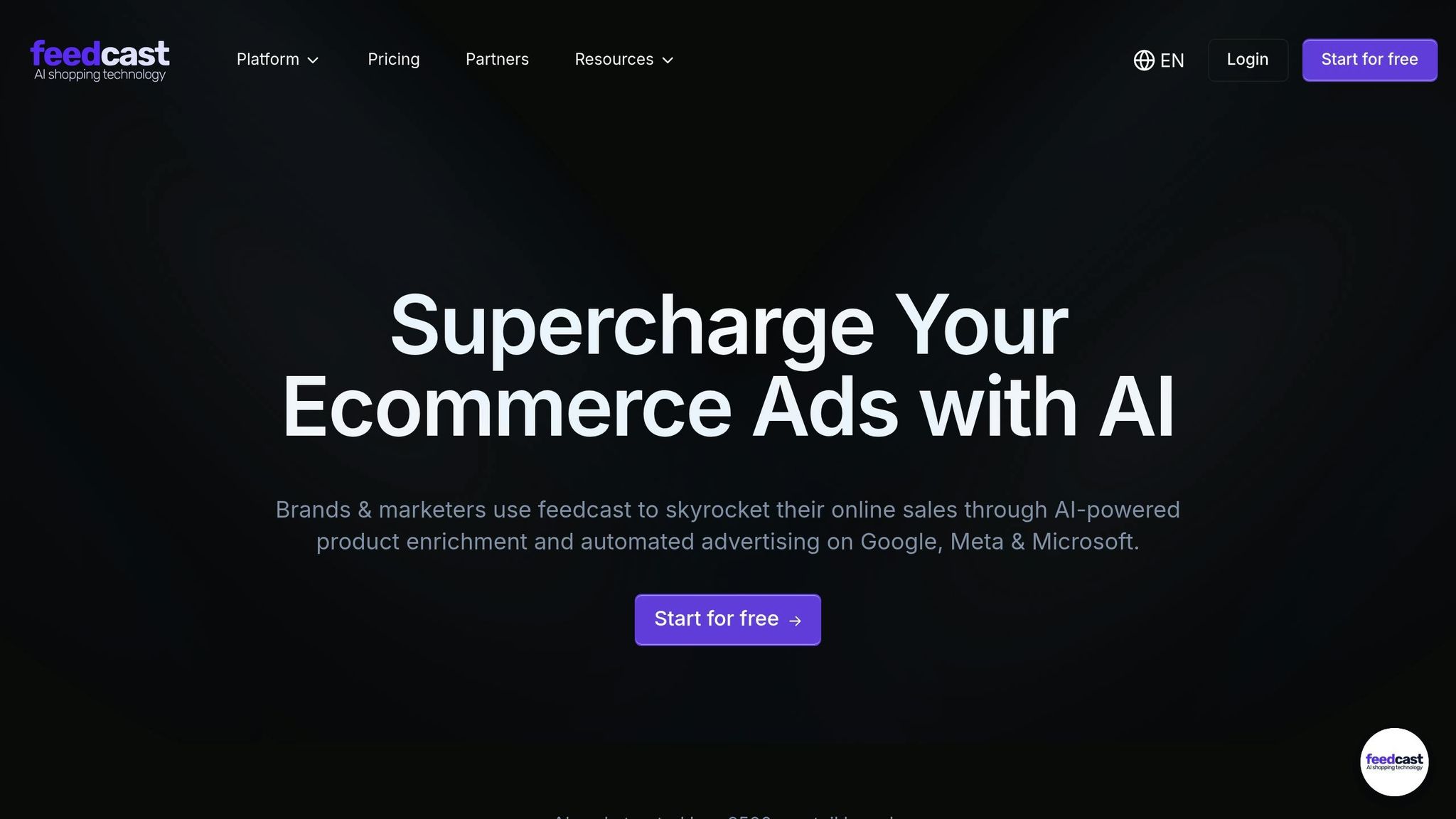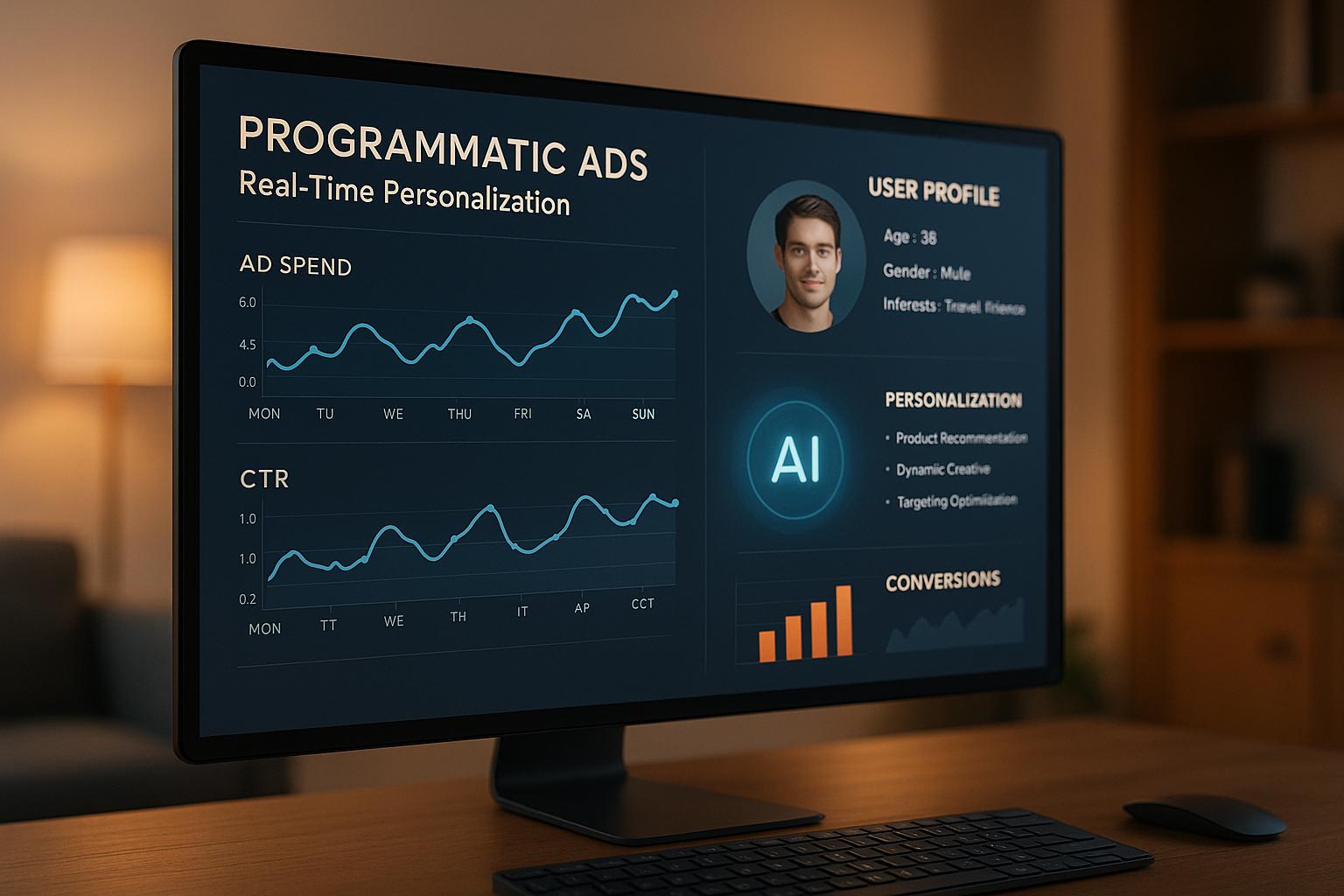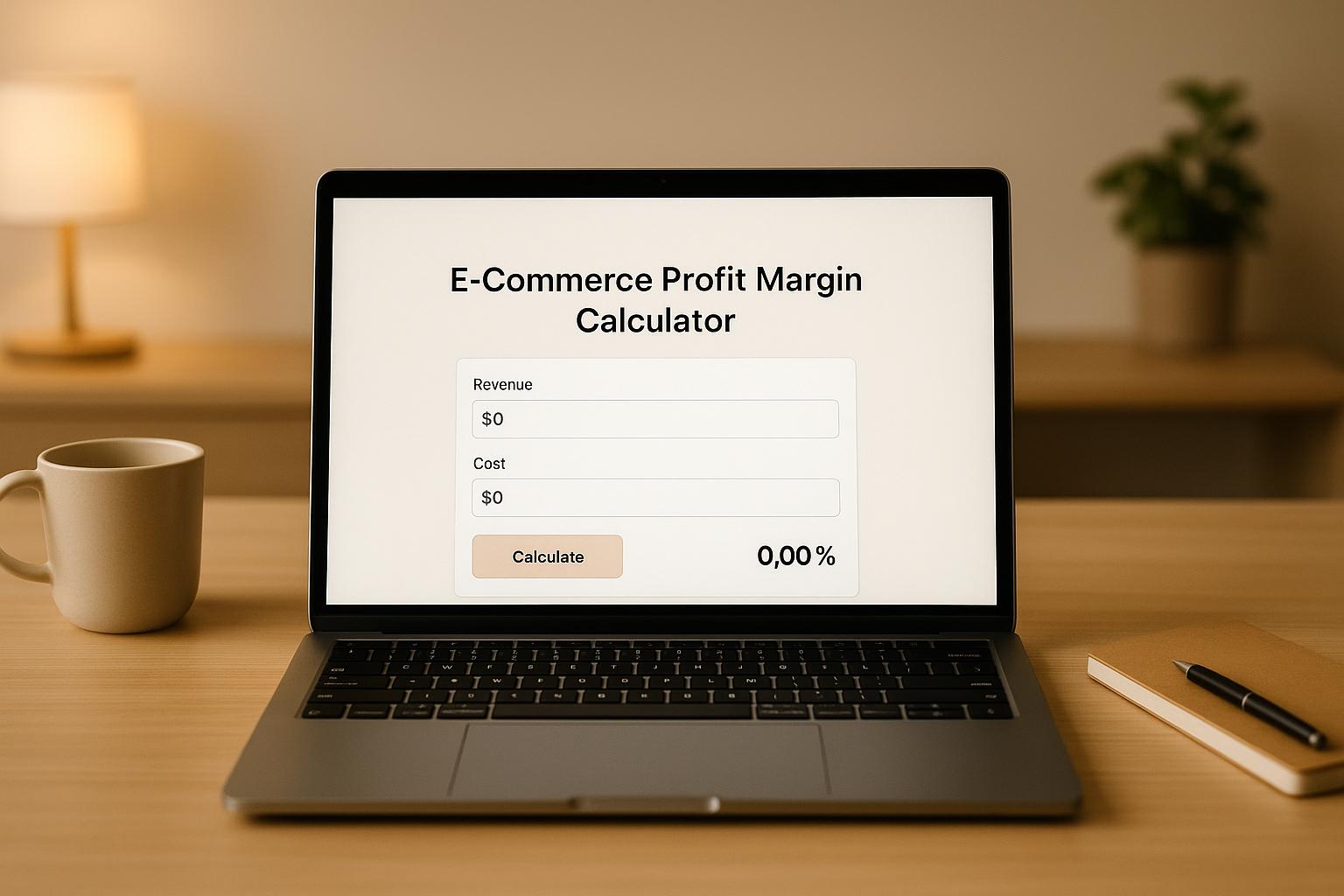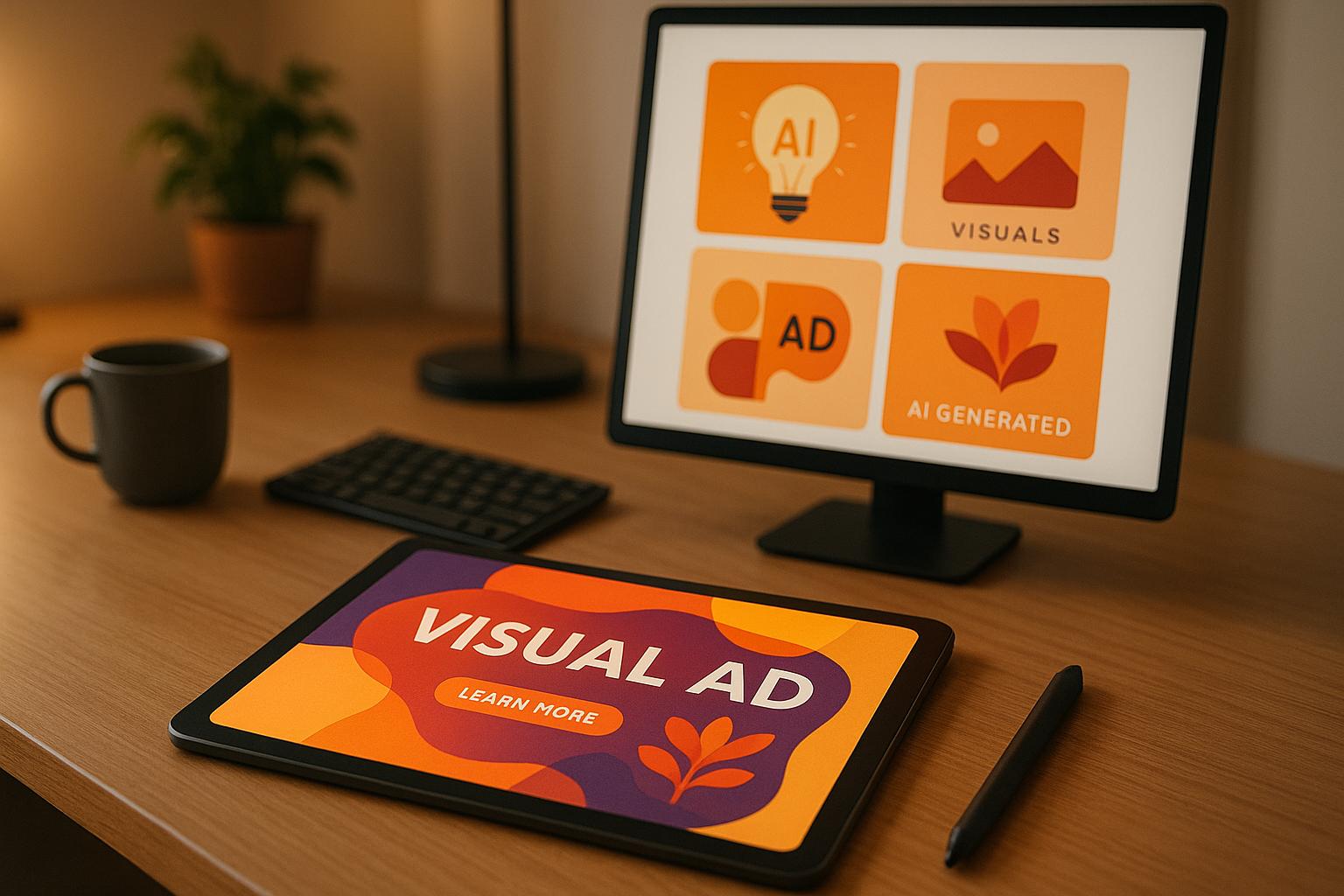AI Tools for Retargeting Metrics Optimization
AI tools are transforming retargeting campaigns by automating data analysis, improving ad performance, and boosting profitability. They help marketers make faster, data-driven decisions across platforms like Google Ads, Facebook, and Instagram. Here's what you need to know:
- Key Metrics: Focus on conversion rate, return on ad spend (ROAS), and cost per acquisition (CPA). AI tools identify patterns, optimize bidding, and improve targeting to maximize these metrics.
- Conversion rates for retargeted users can be 2-10%, far higher than for new visitors.
- AI can improve ROAS by 20-50% and reduce CPA by up to 30%.
- How AI Helps:
- Predictive Analytics: Forecasts high-performing audience segments.
- Automated A/B Testing: Tests and adjusts ads in real time.
- Unified Dashboards: Consolidates data from multiple platforms for better insights.
- Top Tools: Platforms like Feedcast.ai simplify multi-channel management, refine product data, and personalize ad targeting. Others like RollWorks and Quantcast focus on niche needs like B2B targeting or high-intent users.
Bottom line: AI-powered tools save time, reduce errors, and improve campaign results by analyzing data, refining strategies, and automating adjustments. Whether you're optimizing for conversions, profitability, or efficiency, AI offers actionable solutions to elevate your retargeting efforts.
7 Best AI PPC Tools to DOMINATE Paid Advertising in 2025 (Google, Facebook, TikTok & More)
Key Retargeting Metrics to Track and Optimize
Knowing which metrics to focus on can make all the difference when it comes to successful retargeting campaigns. While there’s no shortage of data to analyze, three key metrics stand out as the backbone of effective campaign measurement: conversion rate, return on ad spend (ROAS), and cost per acquisition (CPA).
Each of these metrics serves a unique role in fine-tuning your strategy. Conversion rate shows how effectively your ads turn interest into action. ROAS reveals whether your campaigns are actually profitable. CPA, on the other hand, highlights how efficiently you’re spending to gain new customers. By combining these metrics, AI tools can uncover opportunities that would be nearly impossible to detect manually. Let’s break down each metric and explore how AI helps optimize them.
Conversion Rate
Conversion rate tracks the percentage of retargeted users who take a desired action, such as making a purchase or signing up. It’s especially important in retargeting because these users are already familiar with your brand, making them more likely to convert than first-time visitors.
Data shows that AI-powered retargeting can boost conversion rates by up to 70% compared to campaigns without personalization[1]. This directly impacts revenue. For example, RollWorks found that accounts with engagement spikes are four times more likely to turn into sales opportunities[2]. AI-driven targeting ensures that your retargeted audience is more likely to take meaningful actions.
AI tools improve conversion rates through automated audience segmentation and personalized ad delivery. By analyzing browsing behavior, purchase history, and engagement patterns, these tools create highly targeted campaigns tailored to each audience segment. This kind of precision targeting would take an enormous amount of manual effort but happens instantly with AI. As conversion rates climb, this also strengthens other metrics like ROAS.
Return on Ad Spend (ROAS)
ROAS measures the profitability of your campaigns by dividing revenue by ad spend. For instance, if you spend $1,000 on retargeting and generate $4,000 in sales, your ROAS is 4:1. It’s a no-nonsense metric that cuts through fluff like clicks and impressions to show whether your ads are delivering real returns.
Businesses using AI-powered retargeting platforms often report 20-50% higher ROAS compared to those using manual or rule-based systems[2]. This improvement stems from AI’s ability to optimize bidding strategies, audience targeting, and budget allocation across different channels - all in real time.
AI maximizes ROAS through predictive analytics and automated bid adjustments. These tools analyze performance data on the fly, reallocating budget to focus on the highest-converting audience segments. Underperforming ads get less spend, while successful campaigns receive more attention - all happening dynamically as campaigns run.
Consolidated dashboards provided by AI tools are also game-changers for ROAS optimization. By pulling data from platforms like Google Ads, Meta, and Microsoft Ads into one place, marketers can quickly identify which channels and audiences deliver the best returns. This unified view allows for faster, smarter decisions about where to allocate budget.
Cost per Acquisition (CPA)
CPA calculates the average cost of acquiring a customer through your retargeting efforts. Unlike ROAS and conversion rate, a lower CPA signals greater efficiency. This is where AI-driven targeting truly stands out.
AI tools can reduce CPA by up to 30% by focusing ad spend on high-intent users[2]. Instead of wasting budget on users who are unlikely to convert, AI platforms identify and prioritize the prospects most likely to make a purchase.
This efficiency comes from advanced user scoring and predictive modeling. AI analyzes thousands of data points - like time spent on product pages, cart abandonment, and browsing history - to create detailed user profiles. These profiles help determine which users warrant higher bids and which can be targeted with lower-cost impressions.
One effective tactic involves using AI to filter out low-fit traffic, which can reduce wasted ad spend by as much as 35%[2]. By eliminating users who are unlikely to convert, AI ensures your budget is spent on the most promising prospects, improving both CPA and overall campaign performance.
| Metric | AI Optimization Method | Typical Improvement |
|---|---|---|
| Conversion Rate | Automated audience segmentation & personalization | Up to 70% increase[1] |
| ROAS | Predictive analytics & bid optimization | 20-50% improvement[2] |
| CPA | High-intent user targeting | Up to 30% reduction[2] |
The best retargeting campaigns don’t treat these metrics as separate silos. AI tools excel at balancing all three - boosting conversion rates, increasing ROAS, and lowering CPA simultaneously. This integrated approach is what sets AI-powered campaigns apart from traditional manual strategies.
AI Tools for Retargeting Metrics Optimization
The world of AI-powered retargeting tools has come a long way, making it easier than ever to improve conversion rates, return on ad spend (ROAS), and cost per acquisition (CPA). These tools use predictive algorithms to anticipate user behavior, adjust bids, and personalize messages in real time. By combining advanced analytics with dynamic campaign management, they fine-tune bidding strategies and allocate budgets efficiently. Many platforms now also offer centralized control across major advertising channels like Google, Meta, and Microsoft Ads, simplifying multi-channel management. Among these, tools like Feedcast.ai stand out for their ability to streamline and enhance retargeting efforts.
Feedcast.ai: Simplifying Multi-Channel Retargeting

Feedcast.ai is designed to make managing multi-channel ad campaigns easier while optimizing retargeting metrics. With a single dashboard, it integrates campaigns across Google, Meta (Facebook and Instagram), and Microsoft Ads, saving marketers time and effort.
One of its standout features is AI-driven product data enrichment. Feedcast.ai automatically refines product titles, descriptions, and attributes, ensuring ads are more relevant to user intent. This increased relevance boosts ad visibility and, in turn, improves conversion rates.
The platform also excels in personalized targeting. By analyzing browsing habits, purchase histories, and engagement data, it crafts campaigns tailored to both new customers and existing ones. It even generates customized ad copy for each channel, ensuring the messaging resonates with specific audiences.
Real-time analytics and unified reporting provide actionable insights to improve performance. Marketers can quickly identify underperforming segments and adjust their strategies without needing to switch between multiple dashboards. This streamlined approach not only saves time but also accelerates decision-making.
Another helpful feature is automated error detection for product feeds, which helps resolve issues before they affect campaigns. As a certified Google CSS (Comparison Shopping Service) partner, Feedcast.ai offers added benefits for Google Shopping campaigns, such as reduced costs and improved ROAS. With pricing plans that include a free tier, Feedcast.ai is accessible to businesses of all sizes.
Other AI Tools for Retargeting
While Feedcast.ai offers a comprehensive solution, other platforms focus on specific aspects of retargeting optimization:
RollWorks specializes in account-based retargeting for B2B marketers. Its database of 4.2 billion digital profiles enables precise audience targeting. According to RollWorks, accounts showing spikes in engagement are four times more likely to convert into sales opportunities[2].
Quantcast uses real-time AI insights to deliver ads to users with high purchase intent, optimizing ad delivery for better results.
6sense focuses on identifying in-market accounts and fine-tuning ad spend. Clients report a 35% reduction in low-fit traffic thanks to its predictive modeling capabilities[2].
For those using broader marketing platforms, HubSpot Marketing Hub integrates CRM data with automated workflows to enable seamless remarketing. Similarly, Mailchimp now offers retargeting ad features that align with its email campaigns, creating cohesive cross-channel messaging[1].
Choosing the right tool depends on your business goals and model. E-commerce businesses often benefit from platforms like Feedcast.ai, which handle product feed optimization and multi-channel management. On the other hand, B2B companies may find tools with advanced intent scoring and account-based targeting more suited to their needs.
sbb-itb-0bd1697
Best Practices for Using AI to Optimize Retargeting Campaigns
Building on the advanced metrics and tools discussed earlier, these practices ensure that AI-powered retargeting campaigns deliver strong results. By strategically using automation while maintaining control over objectives and messaging, you can make the most of AI in your retargeting efforts.
Automating Audience Segmentation
AI is incredibly effective at spotting patterns in user behavior that might be missed manually. Instead of relying on basic demographic data, AI tools analyze detailed behavioral insights, purchase history, and engagement trends to automatically create audience segments based on their likelihood to convert.
One key practice is integrating your CRM data with AI platforms. This allows for the creation of dynamic audience segments that update in real time as user behavior changes[1]. For instance, Quantcast uses AI-driven insights to pinpoint users with high purchase intent at the exact moments they’re most likely to respond[1].
To get started, connect your customer data sources - AI platforms typically support data imports from e-commerce systems, email marketing tools, and ad accounts. Once integrated, the AI identifies patterns and builds segments automatically. Regularly check and tweak these AI-generated segments to ensure they align with your campaign goals. This dynamic segmentation provides a solid foundation for delivering tailored product messaging in your ads.
Optimizing Product Data for Ads
The quality of your product data plays a crucial role in the success of your retargeting campaigns, yet it’s often overlooked. AI-powered tools take product data optimization to the next level by refining every detail of how products are presented in ads.
For example, Feedcast.ai uses natural language processing to automatically improve product titles, descriptions, and attributes. This ensures ads are more aligned with user search intent, boosting click-through rates and conversions. The platform also identifies and resolves feed errors before they can disrupt campaign performance.
AI can adapt ad content based on what resonates with specific audience segments. Price-sensitive shoppers might see ads highlighting discounts, while quality-focused users might receive ads emphasizing premium features. With AI continuously monitoring and suggesting improvements, the often-overlooked task of product feed audits becomes automated. This helps prevent issues like ads linking to product pages with incomplete or outdated information. Enhanced product feeds also tie directly into performance monitoring, making a unified dashboard essential for managing ongoing updates.
Using Performance Dashboards
A unified dashboard, like the one offered by Feedcast.ai, brings together real-time metrics from all channels, flags anomalies, and suggests actionable optimizations. These dashboards allow marketers to quickly identify underperforming segments and adjust strategies on the fly. Custom reporting options let you track specific audience groups, product categories, or campaign goals.
Set up real-time alerts for key metrics to respond immediately to unexpected changes in performance. The most effective marketers use these dashboards to test and refine their campaigns continuously. By analyzing how different audience segments interact with various ad creatives and adjusting targeting in real time, they stay agile and responsive to shifts in user behavior. Performance segmentation within these dashboards helps identify top-performing combinations, enabling you to allocate more budget to what works while pausing what doesn’t.
Conclusion: Achieving Success with AI-Powered Retargeting
AI tools are transforming how e-commerce businesses approach retargeting, making campaigns more efficient and measurable. By focusing on metrics like conversion rates, ROAS, and CPA, businesses can evaluate how effectively they re-engage potential customers and drive sales, helping to shape smarter strategies and allocate budgets more effectively[1].
Platforms like Feedcast.ai take the guesswork out of multi-channel advertising by automating repetitive tasks and providing real-time insights. For instance, Feedcast's AI-driven features - like product data enrichment, customized ad creation, and targeted campaigns - help businesses improve efficiency and boost ROI. A case in point: one e-commerce retailer used Feedcast to centralize ad management across Google, Meta, and Microsoft Ads, automate product feed updates, and generate AI-powered ad copy. The result? A 25% jump in conversion rates and a 15% drop in CPA within just three months[1].
These tools don't just save time - they also reduce errors and improve precision. By streamlining processes like segmentation, personalization, and analytics, AI-powered platforms enable businesses to target audiences more accurately, leading to higher engagement and better sales outcomes. The growing adoption of centralized campaign management highlights the value of unified dashboards and automation in simplifying and optimizing advertising strategies[1].
FAQs
How do AI tools improve the effectiveness of retargeting campaigns compared to traditional methods?
AI tools bring a new level of efficiency to retargeting campaigns by analyzing user behavior in real time. This allows for quicker adjustments and more accurate targeting compared to older methods. The result? Ads are delivered to the right audience exactly when they’re most likely to engage.
These tools also shine when it comes to personalizing ad content and fine-tuning audience segmentation. This not only boosts engagement but also drives higher conversion rates. With advanced algorithms working behind the scenes, AI helps ensure your campaigns are fine-tuned for stronger ROI and sustained success.
How can I effectively integrate AI tools into my marketing platforms to improve retargeting performance?
To effectively bring AI tools into your marketing platforms for improved retargeting, start by pinpointing where they can make the most difference. Key areas often include personalized audience targeting, campaign automation, and performance analytics. Make sure any tools you choose work seamlessly with your current platforms, like Google Ads or Meta Ads Manager, and align with your business objectives.
Take it step by step - start by testing AI tools on smaller campaigns to assess their impact before rolling them out on a larger scale. Equip your team with the training they need to make the most of the AI features, and keep a close eye on key metrics to refine your strategies as needed. It's also crucial to maintain high-quality data and follow ethical guidelines to get the best results from your efforts.
Can AI tools be used effectively for both B2B and B2C retargeting campaigns, and how do their strategies differ?
Yes, AI tools can play a powerful role in retargeting campaigns for both B2B and B2C audiences, but the approach varies depending on the goals and needs of each group.
In B2B retargeting, AI is all about precision and building relationships. Since B2B sales cycles tend to be longer, AI helps craft highly tailored content that targets decision-makers and focuses on nurturing leads over time. These campaigns prioritize providing valuable, relevant information to build trust and ensure quality leads.
On the other hand, B2C retargeting leans heavily on speed and emotional appeal. AI uses behavioral data to create personalized ads designed to grab attention quickly and encourage fast purchases. These campaigns aim to reach a larger audience, drive immediate action, and build customer loyalty.
The main difference? B2B campaigns focus on depth and precision, while B2C campaigns emphasize scale and quick engagement.
Yohann B.




